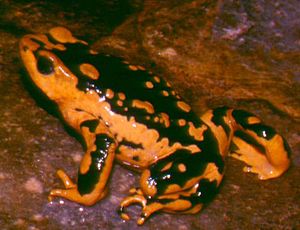Atelopus patazensis facts for kids
Quick facts for kids Atelopus patazensis |
|
|---|---|
 |
|
| Conservation status | |
| Scientific classification |
Atelopus patazensis is a special kind of toad that lives only in Peru. It belongs to a group of toads called Atelopus, which are often brightly colored. This specific toad is found in a small area near a place called Pataz in the La Libertad Region. Scientists first officially described it in 2008.
What Does It Look Like?
Atelopus patazensis is a fairly large toad for its group. Adult males are about 3.5 to 4 centimeters (1.4 to 1.6 inches) long. Adult females are a bit bigger, measuring about 4.3 to 4.9 centimeters (1.7 to 1.9 inches) from their snout (nose) to their vent (tail end).
Its head is about as wide as it is long. This toad does not have a visible eardrum, which is called a tympanum. Its body is strong and sturdy, and its legs are quite short. The fingers on its front feet are not connected by skin, but its toes have some webbing.
The back of the toad, called the dorsum, can be orange with large black swirly or irregular marks. These marks can even go onto its legs. Sometimes, the toad's back is black with orange swirly or irregular marks instead. The belly, or venter, is a solid, bright orange color. Its palms and the soles of its feet are also orange.
Where Does It Live and How Is It Doing?
Atelopus patazensis lives in mountain areas, high up at elevations of 2,500 to 3,000 meters (8,200 to 9,800 feet) above sea level. These areas are mostly covered with tall, clumpy grass and a few scattered bushes. These toads lay their eggs and raise their young in streams.
People used to see many adult toads in their main habitat until 1999. At that time, a dangerous chytrid fungus was found, and some toads were found dead. This fungus causes a disease called chytridiomycosis, which is very harmful to amphibians.
Since then, scientists have had a hard time finding these toads. They have only seen a very small number of adults or tadpoles. Besides the fungus, this toad also faces threats from pollution. This includes pollution from mining activities and trash from homes. Protecting its mountain home and keeping the streams clean are very important for the survival of Atelopus patazensis.
See also
 In Spanish: Atelopus patazensis para niños
In Spanish: Atelopus patazensis para niños


